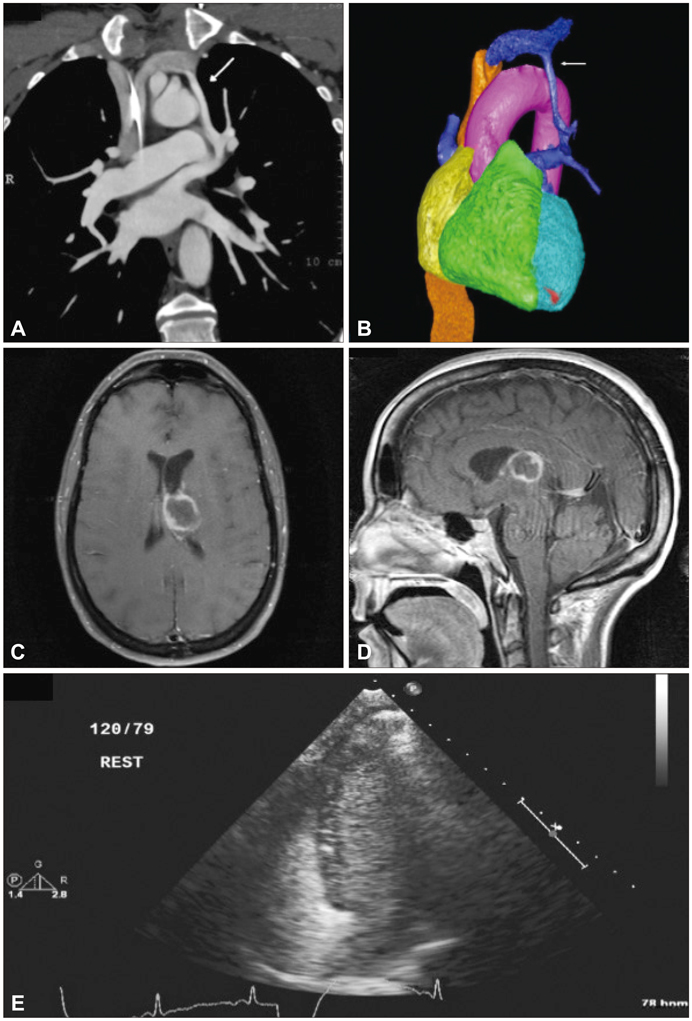J Clin Neurol.
2014 Jan;10(1):55-58.
Novel Partial Anomalous Pulmonary Venous Connection Associated with Brain Abscess
- Affiliations
-
- 1Department of Cardiology, Thomas Jefferson University, Philadelphia, PA, USA. anishkoka@mandalkoka.com
- 2Department of Neurology, Thomas Jefferson University, Philadelphia, PA, USA.
- 3Department of Neurosurgery, Thomas Jefferson University, Philadelphia, PA, USA.
Abstract
- BACKGROUND
Right-to-left vascular shunts are associated with brain abscess.
CASE REPORT
We present a 47-year-old female with a cryptogenic left thalamic abscess on which Streptococcus mitis grew upon aspiration. Computed tomography of the chest with contrast agent revealed an anomalous connection between the left superior pulmonary and brachiocephalic veins. A right-to-left shunt was confirmed in a transthoracic echocardiogram study in which bubbles were injected into the left arm; this shunt had not previously been noted upon right-arm injection.
CONCLUSIONS
We recommend aggressive evaluation for right-to-left shunts in patients who present with cryptogenic brain abscesses. In addition to imaging, this should include a bubble-based study with left-arm saline injection.
Keyword
MeSH Terms
Figure
Reference
-
1. Kawamata T, Takeshita M, Ishizuka N, Hori T. Patent foramen ovale as a possible risk factor for cryptogenic brain abscess: report of two cases. Neurosurgery. 2001; 49:204–206. discussion 206-207.
Article2. Hirth A, Disney P, Thorne S. Brain abscess associated with an unusual cause of right to left shunt. Heart. 2007; 93:34.
Article3. Mathisen GE, Johnson JP. Brain abscess. Clin Infect Dis. 1997; 25:763–779. quiz 780-781.
Article4. Sung CW, Jung JH, Lee SH, Choi S, Cho JR, Lee N, et al. Brain abscess in an adult with atrial septal defect. Clin Cardiol. 2010; 33:E51–E53.
Article5. Trerotola SO, Pyeritz RE. PAVM embolization: an update. AJR Am J Roentgenol. 2010; 195:837–845.
Article6. Whitfield P. The management of intracranial abscesses. Adv Clin Neurosci Rehabil. 2005; 5:12–15.
Article7. Aebi C, Kaufmann F, Schaad UB. Brain abscess in childhood--long-term experiences. Eur J Pediatr. 1991; 150:282–286.
Article8. Takeshita M, Kagawa M, Yonetani H, Izawa M, Yato S, Nakanishi T, et al. Risk factors for brain abscess in patients with congenital cyanotic heart disease. Neurol Med Chir (Tokyo). 1992; 32:667–670.
Article9. Moussouttas M, Fayad P, Rosenblatt M, Hashimoto M, Pollak J, Henderson K, et al. Pulmonary arteriovenous malformations: cerebral ischemia and neurologic manifestations. Neurology. 2000; 55:959–964.
Article10. Troost E, Gewillig M, Budts W. Percutaneous closure of a persistent left superior vena cava connected to the left atrium. Int J Cardiol. 2006; 106:365–366.
Article11. Mahadevan G, Thorne SA, Steeds RP. Echocardiography in cryptogenic cerebrospinal abscess. J Am Soc Echocardiogr. 2008; 21:401–403.
Article12. Kaiser LR, Kron IL, Spray TL. Mastery of Cardiothoracic Surgery. 2nd ed. Philadelphia: Lippincott Williams & Wilkins;2006.13. Walsh R, Fang J, Fuster V, O'Rourke R. Hurst's the Heart. 13th ed. New York: McGraw-Hill;2011.14. Singh S, Geelani MA, Modi P, Niwaria Y, Shahi S, Banerjee A. Anomalous connection of superior vena cava to the left atrium masquerading as epilepsy: a case report with review of literature. Ann Card Anaesth. 2008; 11:42–45.
Article15. Walder LA, Anastasia LF, Spodick DH. Pulmonary arteriovenous malformations with brain abscess. Am Heart J. 1994; 127:227–232.
Article
- Full Text Links
- Actions
-
Cited
- CITED
-
- Close
- Share
- Similar articles
-
- A Case of Surgically Corrected-Combined form of Total Anomalous Pulmonary Venous Return
- Cor Triatriatum Associated with Total Anomalous Pulmonary Venous Connection: A Rare but Plausible Combination
- Surgical Management of Coarctation of the Aorta with a Ventricular Septal Defect and Coexisting Partial Anomalous Pulmonary Venous Connection: A case report
- Levoatriocardinal Vein Combined with Pulmonary Venous Varix Mimicking Arteriovenous Malformations: A Case Report
- Total anomalous pulmonary venous connection-surgical correction and late pulmonary venous obstruction


